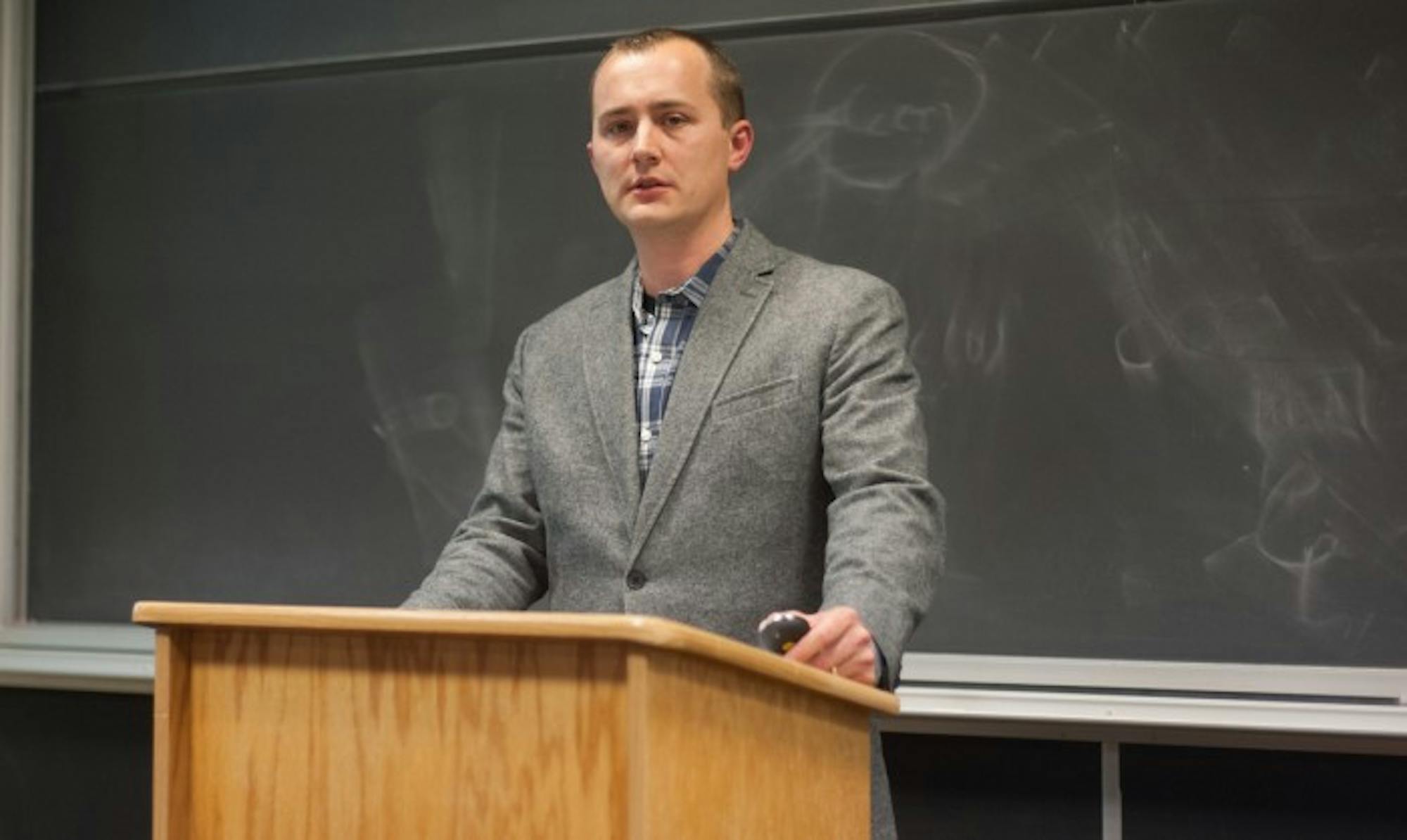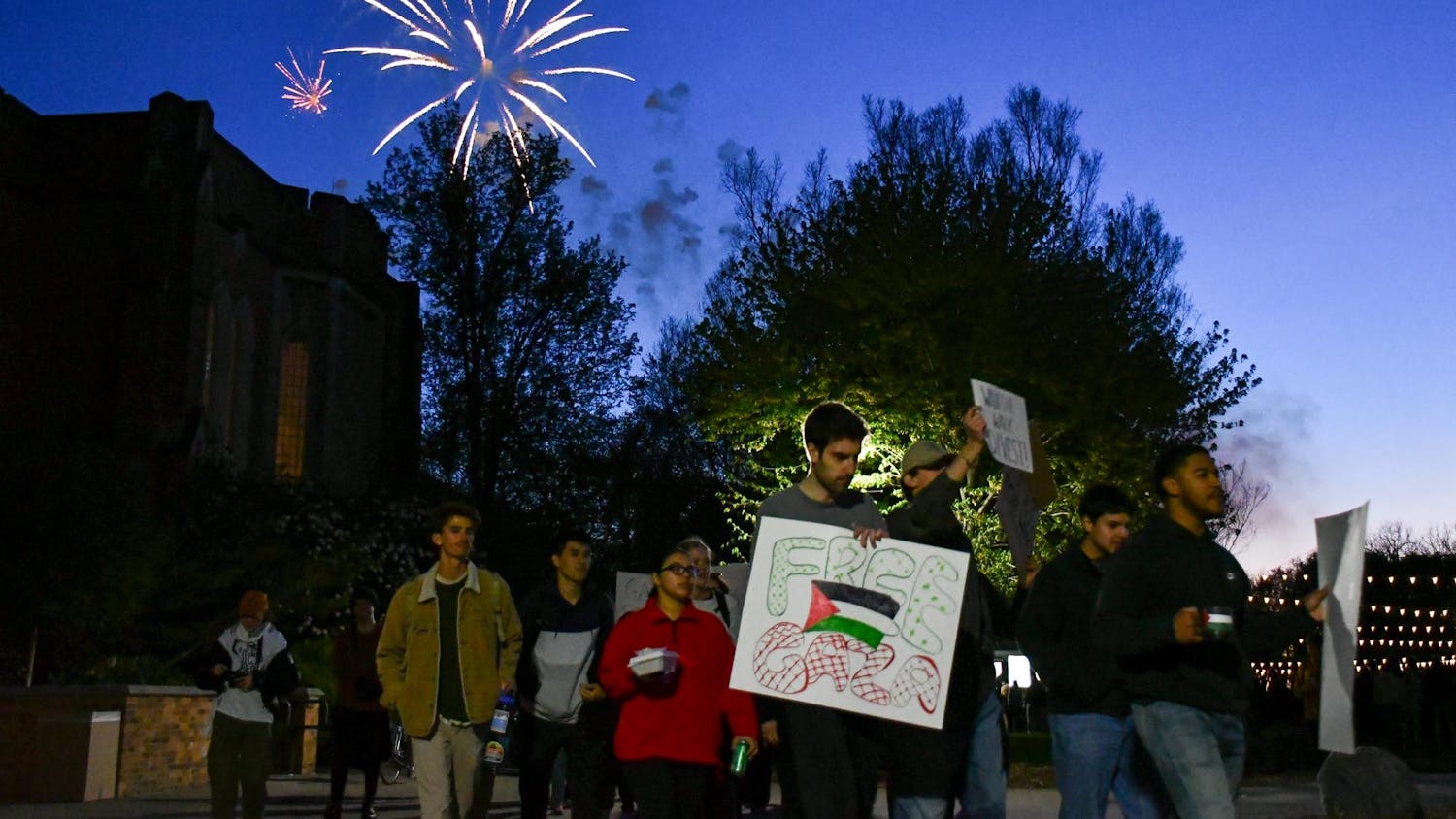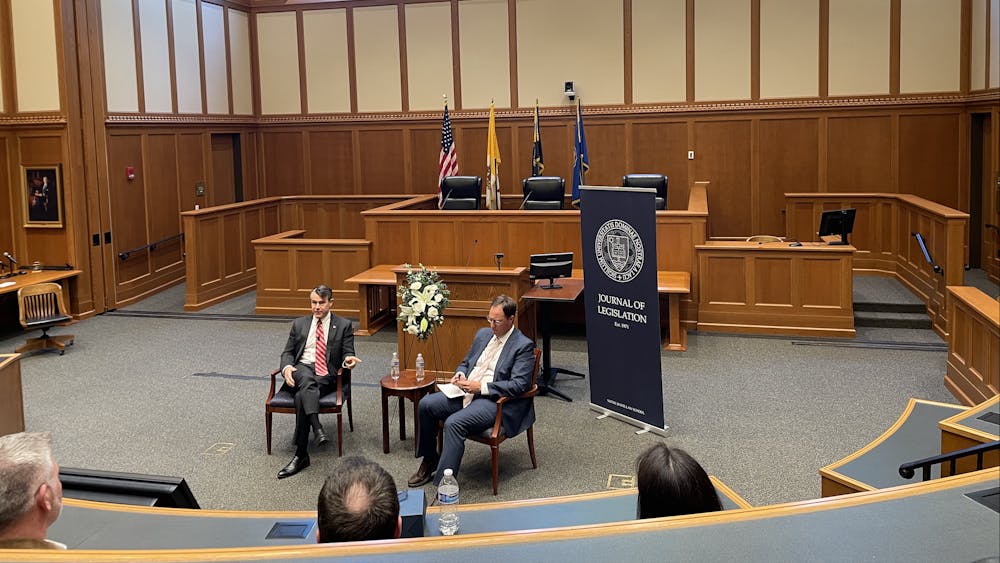Dr. Jeffrey Luppes, assistant professor of German at Indiana University South Bend (IUSB), delivered a lecture Wednesday afternoon titled “German Wartime Suffering and the Holocaust in Postwar Memory.” The lecture was presented as part of the “Germany’s Confrontation with the Holocaust in a Global Context” exhibition.

Chris Collins
Chris Collins
DeBartolo Hall on German wartime suffering and the experiences of German evacuees after the war.
At the end and after the conclusion of World War II, the victorious Allied powers forced approximately 12 million Germans to leave their homelands in Central and Eastern Europe and move to the territory that is now Germany, Luppes said.
“In the events that have become known as flight and expulsion, millions of Germans were evacuated by order of the Nazis or fled westward on their own accord before the war’s end and then were not allowed to return home,” he said. “Large numbers were driven out by vengeful local partisans during the ‘wild’ expulsions in the late spring and early summer of 1945. Innumerable others were forced to relocate as a result of border settlements and the population transfer decreed by the Allies at Potsdam in August of that year.”
The precise number of deaths resulting from violent confrontation, diseases, malnourishment and exposure during the expulsion has been politicized and controversial for decades, Luppes said.
“Informed guesses range from several hundred thousand to two million,” he said.
The survivors and their descendants are referred to as “expellees,” Luppes said. Of the survivors, around eight million settled in West Germany, making up slightly more than 16 percent of the total population.
“The roughly four million newly-arrived expellees in East Germany comprised just under a quarter of the population,” he said.
In the late 1990s and early part of the 21st century, Luppes said, non-Jewish German experiences of World War II and its aftermath became a topic of public discourse in a way that was “hitherto unseen in reunited Germany.”
“Unleashing the societal discussions were some leading literary and cultural figures who probed postwar German responses to the war or who explored subjects and framed their findings in ways long considered improper in light of the Holocaust,” Luppes said.
“A number of documentaries airing in prime time, popular TV miniseries and highly visible cover stories on national magazines reignited … the debate,” he said.
Much of the discussions on representations of German wartime suffering centered on if, and why, the topic of Germans as victims had been taboo, Luppes said, and how best to commemorate German wartime suffering without overshadowing the Nazi war crimes.
“You might wonder what a talk about non-Jewish German victims has to do with a lecture series called ‘Remembrance: The Holocaust in Global Context.’ When it comes to this expansive and contentious topic, it seems that remembrance of German wartime suffering has been inextricably linked to the Holocaust — even more, one might even say it has been in direct competition.
Discourses on German victimhood, particularly the suffering of the expellees, have existed and persisted throughout the postwar era, Luppes said.
“Indeed, the topic ‘flight and expulsion’ has been a constitutive part of national narratives, on the political agenda at all levels and publicly commemorated in every decade after the war,” he said.
Luppes said it can be argued in many ways that the expellees were “primus inter pares,” or first among equals, in comparison to the victims of World War II in Germany, especially for the first quarter-century after the war.
“Therefore, although narratives of German wartime suffering have varied in tone and resonance over the course of the postwar era, the topic has never been taboo, at least in the sense that assertions of German victimhood were nonexistent or disallowed,” he said.
A subtitle for Luppes’ lecture could be “From consensus to contestation,” he said.
“And by that I mean, for the first 25 years after World War II and beyond, German victimhood occupied the largest place in German memory. It was a consensus,” he said. “Postwar memory in Germany tends to crowd out competing narratives. Indeed, not until the 1970s and early 1980s was the Holocaust able to squeeze in. This development was extraordinary and remains a significant achievement.”
Holocaust-centered historical narratives have not been uncontested, Luppes said.
“One could argue that with the explosion of interest in German wartime suffering, the place of the Holocaust in German memory is as tenuous as ever,” he said.
Understanding perceptions of German wartime suffering in the postwar era is critical, Luppes said.
“You might ask, ‘What is at stake here?’ Well, precisely the conditions that allowed for the prominence of German victimhood in postwar memory were those that prevented public commemoration of the Holocaust on a large scale. If a similar setup were to occur again, memories of Germany’s victims, instead of German victims, could be squeezed out again,” he said.
Attitudes on German culpability did not change immediately, Luppes said, and prior to the 1960s discussions of responsibility had facilitated a widespread popularity of the narratives of the past that focused on German victimhood, including those put forward by the expellees.
“The Nuremberg trials in the fall of 1945 and the successive trials from 1946 to 1949, as well as the Allies’ broader efforts to de-Nazify German society did little to implicate the rest of the populace,” he said. “Most attribute the beginning of the more widespread readiness to reassess a remembrance of the German past to a series of high-profile criminal trials, starting with the Einsatzgruppen trial in Ulm in 1958, at which the mass killing of Jews in Poland and the Soviet Union was comprehensively presented in public for the first time.”
In revealing to the world the totality of the Nazi crimes, Luppes said, the trials played an important didactic role in altering the opinions on the fundamental nature of the Third Reich and challenged West German attitudes on culpability.
“Though a distinction must be made between the attitudes of the political class … and the rest of the population, the trials inevitably led to more confrontation with and contemplation about the role played by ordinary Germans in the annihilation of European Jews,” he said.
The long-term logistical efforts to accommodate the influx of ethnic German refugees and expellees were considered unparalleled in German history, Luppes said.
“In fact, many considered the integration of expellees to be one of the great achievements of the German postwar states,” he said. “The efforts are often referenced today in the discussions about handling the huge numbers of incoming refugees in Germany right now. There are important differences, of course.”













